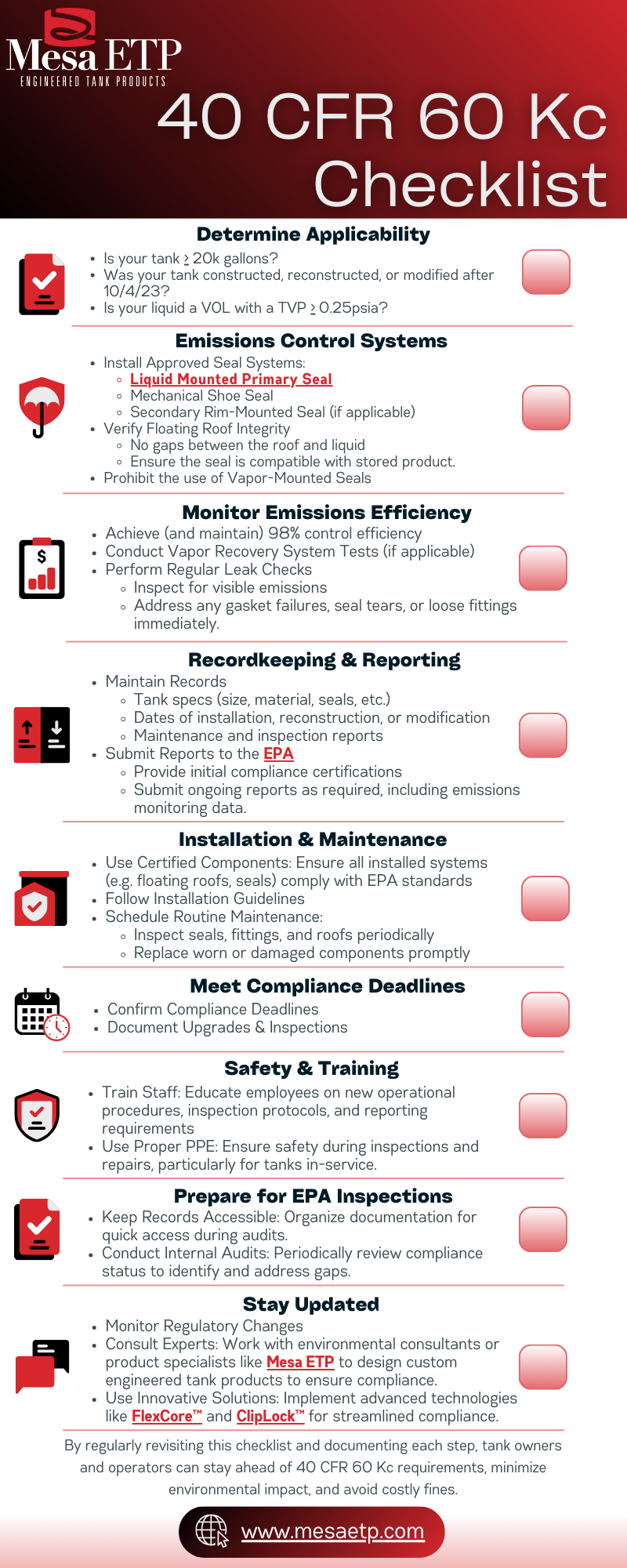Preparing for 40 CFR 60 Kc Compliance: A Step-by-Step Guide

Achieving 40 CFR 60 Kc compliance isn’t just about meeting regulatory requirements—it’s about safeguarding your operations, reputation, and the environment.
Environmental regulations like the EPA’s new 40 CFR 60 Kc play a critical role in emissions control, improving operational standards, and minimizing environmental impact. This regulation focuses on the standards for volatile organic compounds (VOCs) and related emissions from storage tanks. Preparing for compliance is vital—not only to avoid penalties but to ensure sustainable and efficient operations.
In this step-by-step guide, we’ll walk you through how to prepare your tanks, avoid common pitfalls, and streamline the compliance process.
Understanding 40 CFR 60 Kc Regulations for Emission Control
40 CFR 60 Kc is part of the Clean Air Act’s regulations aimed at reducing emissions from storage vessels containing volatile organic liquids (VOLs). It outlines requirements for emissions control monitoring, record-keeping, and the use of compliant control technologies.
Key points include:
- Implementation of proper emissions control systems.
- Accurate reporting and documentation of VOC emissions control.
- Regular inspections and maintenance to ensure compliance.
Get up to speed with our blog on 40 CFR 60 Kc compliance here.
Step-by-Step Process for 40 CFR 60 Kc Compliance
1. Review Your Current Systems
Begin by assessing your existing emissions control systems. Are they aligned with the requirements outlined in 40 CFR 60 Kc? Identify outdated or inefficient processes that need upgrading.
2. Train Your Team
Your staff plays a crucial role in compliance. Ensure everyone involved in operations understands the regulation’s requirements, reporting protocols, and their responsibilities. Host training sessions or partner with experts to educate your team.
3. Set Up Reliable Monitoring Tools
Accurate data collection and reporting are essential. Invest in automated and reliable monitoring systems to track emissions in real time. These tools will help you:
- Generate precise reports.
- Avoid errors caused by manual processes.
- Stay ahead of reporting deadlines by creating a clear compliance timeline.
4. Choose High-Performance Emission Control
Outdated control equipment can hinder compliance and lead to inefficiencies. Replace non-compliant components with advanced solutions like FlexCore™ and ClipLock™, designed for optimal emissions control and performance.
5. Partner with Trusted Experts
Navigating compliance alone can be challenging. Collaborate with industry experts who can:
- Conduct thorough system assessments.
- Help you implement innovative solutions.
- Provide ongoing support for long-term compliance.
Pro Tip: Suppliers like Mesa ETP offer high-quality equipment and expertise to ensure you meet and exceed regulatory standards.
Stumbling Blocks and How to Avoid Them
Procrastination
Starting late is one of the most common mistakes. Begin preparations as early as possible to avoid last-minute errors and rushed installations.
Inaccurate Data
Poorly calibrated monitoring tools can lead to inaccurate emissions control reporting, resulting in non-compliance penalties. Regularly calibrate and maintain your equipment to ensure reliability.
Regulation Misunderstandings
Compliance can be complex, and misinterpreting requirements can lead to costly mistakes. Work closely with compliance consultants to fully understand your obligations and implement the correct measures.

Final Insights
Early preparation and a proactive approach are key to achieving 40 CFR 60 Kc compliance. From assessing your current systems to partnering with trusted experts, each step you take brings you closer to meeting deadlines and avoiding costly errors.
The sooner you start preparing for 40 CFR 60 Kc compliance, the easier it will be to meet deadlines and avoid costly mistakes.
Explore FlexCore & ClipLock Solutions
For detailed regulatory standards, visit the EPA’s official page.
Read Our In-Depth Blog on Compliance
Download Our Compliance Checklist:

Monthly Archives
- March 2025
- February 2025
- December 2024
- November 2024
- May 2024
- April 2024
- January 2024
- October 2023
- August 2023
- May 2023
- April 2023
- June 2022
- May 2022
- September 2021
- July 2021
- January 2021
- August 2020
- July 2020
- May 2020
- April 2019
- January 2019
- November 2017
- October 2017
- July 2017
- June 2017
- May 2017
- April 2017
- February 2017
- November 2016